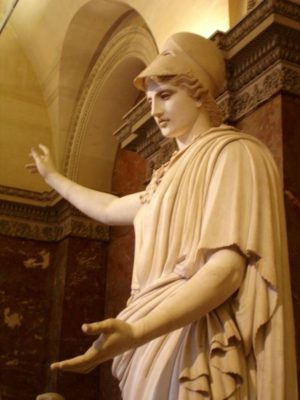The Thermodynamics of High Culture
“Man’s purpose on earth …is to create order.” — Maxim Gorky
THERMODYNAMICS, as the name implies, originated as a systematic study of the processes used to convert heat into a more useful form of energy. An empirical science that has now been thoroughly developed, thermodynamics can be useful in analyzing not only heat engines but also the socioeconomic-genetic systems known as High Cultures.
A common property of an ordered system is that the aggregate, due to the interactions of its constituents, has very different properties than its parts. Consider a deck of cards. The deck, which is a gaming system, has very different properties than any single card. A new deck is arranged in perfect order according to rank and suit as it-comes from the manufacturer. It may be considered to have zero entropy (disorder). On the other hand, shuffling the deck has the purpose of maximizing its entropy.
Another example of an ordered system is a dictionary, which is composed of 27 symbols (26 letters and a blank space) arranged in a certain order. As such, it is a system which is useful only when its entropy is zero (no typographical errors) or low (few typographical errors).
High Cultures are systems composed of interacting individuals, who in their aggregate have very different characteristics than individuals themselves. High Cultures require a high degree of socioeconomic interaction to produce cities, transportation systems, communication networks and spacecraft. High Cultures also require a highly ordered technology, which is stored in libraries and in the minds of individuals. Ultimately, the entire system rests on the genetic quality of certain subsets of individuals (the culture-bearing strata) within the culture.
High Cultures can be distinguished from primitive cultures in that the former need many fewer man-hours to obtain adequate food supplies. This is of great importance, for labor not directed toward food production enables the culture to produce ordered systems (environmental entropy reduction).
The individual particles in a thermodynamic system interact by exchanging energy. The individuals within a High Culture interact by exchanging ideas and commands (through language) and labor (through the marketplace). Since the individuals within the culture are (in the language of physics) created and annihilated, they also interact by exchanging genes. Consequently, the genetic component of a High Culture is by far the most important, especially as it applies to the long-term evolution of such a system.
Irreversibility
Before the physical nature of thermodynamic entropy was discovered, it was already known that for any physical process, such as the compression of gas in a cylinder, the entropy of the system plus the entropy of the environment (everything immediately outside the system) must increase (irreversible process) or remain the same (reversible process). The entropy of a system can therefore decrease only if there is at least an equal increase in the entropy of the larger system containing it. Putting this in order-disorder terms, a system can become more ordered only if there is some corresponding disorder outside of the system. This is the content of the Second Law of Thermodynamics (SLTD).
Consider a billiard ball striking an ordered array of balls on a table. There are countless possible final states, which are all more disordered than the original state. The same effect may be obtained by dropping and smashing a drinking glass, which produces an even greater amount of entropy. In both these examples of an irreversible process, there is more entropy in the final state.
Violations of the SLTD may be artificially observed by watching a movie film run backwards, which reverses the initial and final state. By reversing a film we can watch billiard balls at rest roll, speed up and converge into a perfect triangle. Or we can watch random sizes and shapes of shattered glass arrange themselves and fuse into a drinking glass. Clearly, none of these processes occurs in nature.
Evolution
Arguments against the theory of biological evolution have been based on the SLTD. To some, the development of biological systems through random processes is as credible as the thought that an explosion would produce a dictionary. However, let the proposer of such an analogy compare the civilized level of the West today to its level during the Middle Ages. Isn’t the West in a more highly ordered state, even after two world wars? The existence of such highly ordered systems as highways, railway networks, telephone systems, computers and myriad other developments would answer this question affirmatively. In fact, the entire world has now reached a more ordered state, thanks to Western technology.
This loss of entropy is analogous to the loss of entropy occurring when highly evolved creatures first appeared on our planet. We know that a decrease in entropy does not contradict the SLTD, as long as there is a corresponding increase in entropy outside of the system. For an example we have only to look to the irreversible nuclear processes which release energy from the sun.
As previously pointed out, billiard balls may be arranged into a triangle (zero entropy state) by a small labor input. The deck of cards can be picked up and sorted down to zero entropy with a little more effort. Even the smashed glass could be rebuilt, though such effort would require not only human work, but also the burning of fossil fuel (or other sun-derived product) to re-fuse the glass. In each case, the entropy of a system was reduced by using energy from the sun, which by the process known as photosynthesis produces vegetation, the principal source of energy for all life on earth.
The entropy of earthly systems decreases as the entropy of the sun increases. Evolution (the appearance of more highly ordered biological systems) can take place because the sun is a compensating source of entropy generation. Just as a heat engine produces ordered (linear) motion from the random motion of hot gases, an evolutionary system produces more highly ordered organisms by the random interaction of biological species. The former is possible due to the ejection of hot gases into the atmosphere, the latter through the biological failure of most mutations. Both are made possible by the interaction of the earth with sunlight (fossil fuel for the heat engine, vegetative fuel for the evolutionary system). The earth can become more orderly with time only because it is a subsystem of the solar system.
Labor and Money
To consider economic activity in a thermodynamic light, recall that an ordered deck of cards thrown into the air comes to rest in a more disordered state. However, the initial state (the ordered deck in the hand) can be restored by labor input picking up the cards one at a time and sorting them. This entropy reduction of the deck of cards is consistent with the Second Law of Thermodynamics. The irreversible nuclear burning of the sun (entropy increase) “paid for” the decrease in entropy of the deck of cards. Labor, therefore, is associated with entropy reduction.
Labor is also associated with money. In a culture whose currency has not been debased and is still fully convertible to a commodity produced by labor, the unit of money represents an average given amount of labor. A coin, forexample, has the ability to reduce environmental entropy. To make this idea clearer, consider an individual with money, who is confronted with certain undesirable irreversible processes. If his car is wrecked, it is no problem, providing he has the wherewithal to buy a new one. If his shoes wear out, he purchases another pair. His watch loses time; he pays to have it repaired. In each case, problems caused by an undesirable irreversible process are solved by the use of money. For those who possess it, money has the property of entropy reduction.
Money also gives its possessors the power to destroy. War is a state in which money is used to generate rather than to reduce entropy. The generation of entropy (orderly destruction of ordered systems) is classically directed against other competitors (in a Darwinian sense). Unfortunately, war can also be waged within the same culture, thereby doing great damage to the cultural entity. The American Civil War and both world wars are all too painful examples. The greatest loss is the genetic material, which is the nucleus and source of all cultural elan and activity.
In more primitive cultures, labor is chiefly spent in hunting or searching for food supplies. Primitive men live in or near a state of nature because little labor input is available for the environmental entropy reduction that builds cities and towns. Consequently, there is little money and few goods which can be bought with money. The higher the culture, the more labor may be expended on pursuits other than food production. High Culture is based on this distinction.
Parasitism
Spengler has suggested that High Culture may best be understood as an organism, individuals being cells of the cultural body. The brains of the organism are its rulers. Its factories are organs which produce goods which flow through its transportation networks (arteries). Each organ is a set of individuals who collectively perform certain vital functions. These organs are therefore subsystems of the cultural system.
Alien systems can also enter the cultural body. As in the human body, they are chiefly harmful and dysfunctional. There are exceptions, since certain bacteria can be beneficial. (The Norse invasions, for example, had a long-term beneficial effect in the West.) However, most alien systems are counterproductive, even to the point of cultural death. Symptoms of sickness appear as social disorders, such as the demonetizing of hard currency or in later stages the urban riots in England and the United States. Cultural death proceeds at a slower pace than physical death, as the two follow a different timetable.
Alien systems and degenerate indigenous systems (criminal groups) cause dysfunctions of the socio-economic-genetic system in various ways. The economic dysfunction occurs when an alien subsystem diverts nourishment (money or goods) away from laborers within the cultural body.
Looking at this phenomenon thermodynamically, recall that no system can become more ordered unless there is a compensating disorder in the larger system of which it is a part. Also recall that the culture’s standard commodity (money) is a form of order. Therefore, if a subsystem immersed in a culture absorbs a quantity of money, there must be a compensating outflow of manufactured goods (also ordered structures) for the subsystem to be in harmony with the balance of the cultural entity. If this is not the case, the subsystem or alien system is defined as parasitic, and the SLTD demands disorder somewhere else in the cultural entity. The disorder may take many forms, from unhappy or angry individuals to strikes and civil insurrections. As an example, consider the simplest uncompensated absorption of money — theft — the thermodynamic nature of which has many consequences.
Absorption of unearned money is one type of parasitic activity. There are others. Every culture has its moral code, which its members adhere to for the preservation of order. Everyone who has raised children can appreciate the labor involved in instilling this code into the young. In an ordered system produced by labor, the code is equivalent to a commodity and may be converted to money by parasites. The immorality of parasites feeds upon the High Culture’s moral standards.
The labor aspect of parasitic behavior within a culture is not the domain of any unique group, although the alien (minority) component is well known and ever-present. However, the social aspect of parasitic behavior in the West is almost totally the domain of World Jewry, which has records of civilizations from the earliest times and knows the rules of life on an individual and cultural level. This knowledge, representing a high degree of order, was produced by the labor of Jewish historians and intellectuals interacting with various cultures in which they were immersed. This information remains the property of the Jews, with no credit given to the cultures in which they lived and thrived. Letting this information flow outward would no doubt benefit Western nations. The leadership of Jewry has, on the contrary, chosen to keep this information under lock and key. Instead, Jewish leaders use this knowledge to inject disorder into the Western nations in which they live. This disorder takes the form of social theories (Marxism, Freudianism, equalitarianism) whose fundamental axioms have been known to be false from the outset. Have any theories produced so much suffering and confusion in all human history? The conscious or unconscious implantation of false ideas in a cultural system loads it with entropy.
High Cultures are also threatened by the absorption of genes from an inferior stock. The racially mixed child (future citizen) can do nothing about his condition; it is irreversible. A culture can recover from race-mixing if the bad genes are eliminated from the population, geographical separation being the simplest method. Only in this sense is the cultural damage reversible. However, there is a point at which the damage becomes irreversible. Geographical separation of the races is ineffective when no distinct lines of racial demarcation remain.
The introduction of a toxic amount of entropy in a High Culture’s gene pool by race-mixing is in reality a form of genocide. Westerners might possibly forgive aliens for thieving and lying. Such damage can be repaired with enough time and effort. However, the dilution of the original productive stock of a High Culture by racial intermarriage is more than a glaring example of how the Second Law of Thermodynamics works in human societies; it is the greatest of all crimes since it turns the march of mankind backward toward the primeval ooze from which nature’s most complex and highly ordered creatures so laboriously evolved.
March, 1982
Read more at Jamie Kelso’s online Instauration archive






